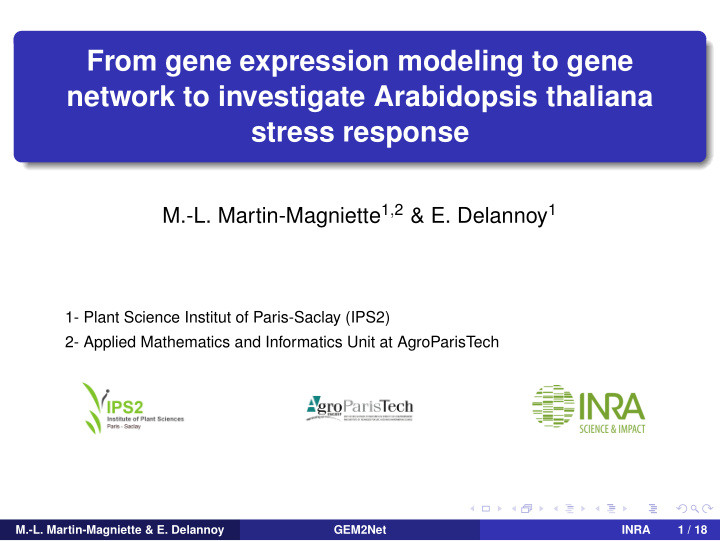



From gene expression modeling to gene network to investigate Arabidopsis thaliana stress response M.-L. Martin-Magniette 1 , 2 & E. Delannoy 1 1- Plant Science Institut of Paris-Saclay (IPS2) 2- Applied Mathematics and Informatics Unit at AgroParisTech M.-L. Martin-Magniette & E. Delannoy GEM2Net INRA 1 / 18
Functional annotation Definition or prediction of the gene functions and of the relationship between them Between 20% and 40% of the predicted genes have no assigned function (Hanson et al , 2009) For Arabidopsis thaliana , only 16% of the genes have a validated function Orphan genes Defined has genes without homologs with a known function (Fukushi and Nishikawa, 2003) Usually discarded of the published studies 5015 orphan genes in A. thaliana (Zaag et al , 2015) M.-L. Martin-Magniette & E. Delannoy GEM2Net INRA 2 / 18
by sequence similarity Based on a comparison of protein sequences to identify structural similarities Nevertheless A high similarity does not guarantee a functional similarity (Tian et al , 2003) Some sequences with a low similarity may share a same function (Galperin et al , 1998) Protein sequence comparison gives information about the biochimical function (Nehrt et al , 2011) M.-L. Martin-Magniette & E. Delannoy GEM2Net INRA 3 / 18
by omics analysis Based on guilt by association studies by identification of genes having similar features at the molecular level M.-L. Martin-Magniette & E. Delannoy GEM2Net INRA 4 / 18
by omics integration Integrating various resources of omics data improves the success of prediction (Radiovojac et al , 2013) But various sources of heterogeneity exist Data are qualitative or quantitative Available information describes the biological entities or their relationships Observations are obtained with various techniques Various semantic frameworks are used M.-L. Martin-Magniette & E. Delannoy GEM2Net INRA 5 / 18
From Gene Expression Modeling to Networks M.-L. Martin-Magniette & E. Delannoy GEM2Net INRA 6 / 18
A dedicated transcriptomic dataset 387 transcriptomic comparisons in dye-swap dedicated to stress 2/3 describe abiotic stresses and 1/3 biotic stresses All the data were generated on the same transcriptomic platform with the same protocol First results Based on differential analyses, 60% of the genes coding proteins have their transcription impacted directly or not by a stress Large overlap of impacted genes between biotic and abiotic stress M.-L. Martin-Magniette & E. Delannoy GEM2Net INRA 7 / 18
Coexpression study using mixture model M.-L. Martin-Magniette & E. Delannoy GEM2Net INRA 8 / 18
Annotation of coexpressed genes M.-L. Martin-Magniette & E. Delannoy GEM2Net INRA 9 / 18
Visualisation by type of resource Pie size proportional to cluster size Colors indicate biological biases M.-L. Martin-Magniette & E. Delannoy GEM2Net INRA 10 / 18
Visualisation of interactions M.-L. Martin-Magniette & E. Delannoy GEM2Net INRA 11 / 18
Overview of a cluster M.-L. Martin-Magniette & E. Delannoy GEM2Net INRA 12 / 18
Vertical integration Results Numerous enrichments Overlap with TF regulations and PPI Conclusions on this large-scale co-expression study It generates meaningful groups of genes It performs favorably as compared to those obtained with correlation-based approaches (higher % of enrichments) Nevertheless 18 co-expression studies were generated Interpretation and use are not straightforward Co-expression is not enough to suggest co-regulation and to be used in a guilt by association approach (Dhaeseleer et al. , 2000) M.-L. Martin-Magniette & E. Delannoy GEM2Net INRA 13 / 18
Horizontal integration M.-L. Martin-Magniette & E. Delannoy GEM2Net INRA 14 / 18
From coexpression to coregulation Small overlap between two clusters of two different stresses Horizontal integration done at the level of the gene pairs Method For each pair of genes, calculation to be in a same cluster of co-expression Comparison with a random network: a pair observed more than 3 times is statistically significant (resampling test) M.-L. Martin-Magniette & E. Delannoy GEM2Net INRA 15 / 18
Coregulation network 5 626 genes and 57 833 interactions 713 orphans and 1 682 with a missing GOSlim annotation Degree distribution is a power law Considered as an important quality criterion (Gillis et Pavlidis, 2012) M.-L. Martin-Magniette & E. Delannoy GEM2Net INRA 16 / 18
Topological properties The network with gene pairs conserved in at least 7 stresses 415 genes with 41 orphans, 1 908 interactions Cis-regulatory motifs found with PLMDetect (Bernard et al. , 2010) 10 components are enriched in motifs For 4 components, the motif is present in over 80% of the gene promotors Component 2 has 5 motifs related to the light regulation, present at most in 50% of gene promoters M.-L. Martin-Magniette & E. Delannoy GEM2Net INRA 17 / 18
Conclusions Coregulation modules are more specific and more homogeneous Cis-regulatory motifs are found in their promoters Topological analysis = an approach to identify functional modules M.-L. Martin-Magniette & E. Delannoy GEM2Net INRA 18 / 18
Recommend
More recommend